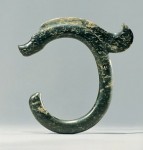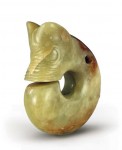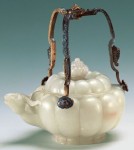Jade artifacts of the Liangzhu culture – 1
 A jade cong produced 3,300-2,200 years ago, a typical art object of the Liangzhu culture. For its size, it is dubbed as “king of all congs”” width=”90″ height=”65″ />Back in the early 20t h century, in Shanghai, adventurers and merchants from the West were able to buy some jade artifacts unique in shape and strange in design. One is a long hollow piece of jade carved with images so strange that it was difficult, if not impossible, to tell whether they were human or supernatural. People had no idea of where, when and for what purpose the jade piece was produced, including even the person who sold it.
A jade cong produced 3,300-2,200 years ago, a typical art object of the Liangzhu culture. For its size, it is dubbed as “king of all congs”” width=”90″ height=”65″ />Back in the early 20t h century, in Shanghai, adventurers and merchants from the West were able to buy some jade artifacts unique in shape and strange in design. One is a long hollow piece of jade carved with images so strange that it was difficult, if not impossible, to tell whether they were human or supernatural. People had no idea of where, when and for what purpose the jade piece was produced, including even the person who sold it.
Two or three decades later, in Yuhang County of Zhejiang Province, east  China, archeologists found some jade artifacts identical in shape and design to the piece mentioned in the proceeding paragraph, but they were still at a loss for when such objects were produced. It was not until the 1980s did experts conclude that these relics belong to the Liangzhu culture dating back to 3,500-4,000 years ago in some areas on the lower reaches of the Yangtze River. This came after excavations on Mt. Caoxie and Mt. Zhangling in Wuxian County, Jiangsu Province, during which numerous jade artifacts of the Neolithic Age were found, including cong (long, hollow pieces with triangular sides), bi (round piece with a hole in the middle), as well as yue (battle-ax). Likewise, the Shanghai jade piece sold in the early 20th century was identified as a typical art object of the Liangzhu culture.
China, archeologists found some jade artifacts identical in shape and design to the piece mentioned in the proceeding paragraph, but they were still at a loss for when such objects were produced. It was not until the 1980s did experts conclude that these relics belong to the Liangzhu culture dating back to 3,500-4,000 years ago in some areas on the lower reaches of the Yangtze River. This came after excavations on Mt. Caoxie and Mt. Zhangling in Wuxian County, Jiangsu Province, during which numerous jade artifacts of the Neolithic Age were found, including cong (long, hollow pieces with triangular sides), bi (round piece with a hole in the middle), as well as yue (battle-ax). Likewise, the Shanghai jade piece sold in the early 20th century was identified as a typical art object of the Liangzhu culture.
Jade artifacts of the Liangzhu culture are found mainly in Jiangsu, Zhejiang  and Anhui provinces on the lower reaches of the Yangtze River. A social estate system was already in place in these areas when these were produced, under which the privileged depended, in addition to forces of arms, on divine power and witchcraft to run roughshod over their subjects, the majority of the local people. That may explain why we attribute most jade artifacts of the Liangzhu culture – cong, bi as well as objects that take the shape of hats, semi-circles or three-throng spears to primitive witchcraft and worshipping of the supernatural. As a matter of fact, these artifacts are often geometrical in shape with symmetrical patterns engraved on them, in a style that denotes solemnity. While the largest in size, Cong pieces– those long, hollow pieces with triangular sides –outnumber jade artifacts of all other types belonging to the Liangzhu culture.
and Anhui provinces on the lower reaches of the Yangtze River. A social estate system was already in place in these areas when these were produced, under which the privileged depended, in addition to forces of arms, on divine power and witchcraft to run roughshod over their subjects, the majority of the local people. That may explain why we attribute most jade artifacts of the Liangzhu culture – cong, bi as well as objects that take the shape of hats, semi-circles or three-throng spears to primitive witchcraft and worshipping of the supernatural. As a matter of fact, these artifacts are often geometrical in shape with symmetrical patterns engraved on them, in a style that denotes solemnity. While the largest in size, Cong pieces– those long, hollow pieces with triangular sides –outnumber jade artifacts of all other types belonging to the Liangzhu culture.
Jade artifacts of the Hongshan culture
 The Hongshan culture existed about 5,000 years ago, in areas drained by the Liaohe and Xilamulun rivers in northeast China. Jade artifacts of the Hongshan culture are recognized as unique in workmanship and regional character. Most of them take the shape of animals, including turtles, fish hawks, cicadas and dragons, and are just three or four centimeters long with holes drilled through–obviously personal ornaments hanging from the belts of their owners.
The Hongshan culture existed about 5,000 years ago, in areas drained by the Liaohe and Xilamulun rivers in northeast China. Jade artifacts of the Hongshan culture are recognized as unique in workmanship and regional character. Most of them take the shape of animals, including turtles, fish hawks, cicadas and dragons, and are just three or four centimeters long with holes drilled through–obviously personal ornaments hanging from the belts of their owners.
A jade dragon, 26 centimeters long, lays coiled like alphabet C. It is too large  and heavy to be used as a personal ornament. Jade dragons similar in shape but much smaller have been identified as belonging to the Hongshan culture, inferring that the larger jade dragon could be the symbol of something supernatural that held people in awe. To be more specific, the artifact could be hung for worshipping on some special occasions, say at sacrificial ceremonies. If the inference is correct, we may say that jade artifacts were no longer used purely as ornaments in times of the Hongshan culture. Time had begun for use of jade artifacts as ceremonial objects as well.
and heavy to be used as a personal ornament. Jade dragons similar in shape but much smaller have been identified as belonging to the Hongshan culture, inferring that the larger jade dragon could be the symbol of something supernatural that held people in awe. To be more specific, the artifact could be hung for worshipping on some special occasions, say at sacrificial ceremonies. If the inference is correct, we may say that jade artifacts were no longer used purely as ornaments in times of the Hongshan culture. Time had begun for use of jade artifacts as ceremonial objects as well.
“Beautiful stones” and jade
 In making and polishing stone tools, prehistory Chinese found that some stones are exceptionally beautiful with smooth surfaces and lustrous colors. Such stones were broadly referred to as yu, which means “jade”. In Studies of the Principles on Composition of Characters, the very first Chinese dictionary compiled by Xu Shen of the East Han Dynasty (25-220 AD), the character yu is denoted as “beautiful stones”. The so-called “beautiful stones” are not exactly what is termed as “jade” in modern mineralogy. Modern mineralogy classifies jade into “hard jade”, in fact jadeite, which is as hard as glass or even harder, and “soft jade”, which is less hard than glass. To put it in scientific language, hard jade has a 7-degree Vicker’s hardness or greater, while soft jade is leas hard. “Beautiful stones” are none other than “soft jade”, which is good for carving.
In making and polishing stone tools, prehistory Chinese found that some stones are exceptionally beautiful with smooth surfaces and lustrous colors. Such stones were broadly referred to as yu, which means “jade”. In Studies of the Principles on Composition of Characters, the very first Chinese dictionary compiled by Xu Shen of the East Han Dynasty (25-220 AD), the character yu is denoted as “beautiful stones”. The so-called “beautiful stones” are not exactly what is termed as “jade” in modern mineralogy. Modern mineralogy classifies jade into “hard jade”, in fact jadeite, which is as hard as glass or even harder, and “soft jade”, which is less hard than glass. To put it in scientific language, hard jade has a 7-degree Vicker’s hardness or greater, while soft jade is leas hard. “Beautiful stones” are none other than “soft jade”, which is good for carving.
Jade, or “soft jade” to be exact, became the sole “beautiful stone” for making art objects with during the Shang-Zhou period (1,600 BC – 256 BC). The earliest jade artifacts known to us are personal ornaments produced about 7,000 years ago, including hairpins for men, as well as beads and eardrops. These were excavated from the fourth cultural stratum of the Hemudu ruins on the lower reaches of the Yangtze River and the Banpo ruins in Xi’an, Shanxi Province. Immediately after their birth, jade artifacts came to be valued for a unique aesthetic beauty relative to stone, wooden, bone and pottery objects and were taken as symbols for monarchical powers represented by military chieftains and divine powers by wizards. In the most recent three decades, large numbers of jade artifacts have been unearthed from tombs of aristocrats that date back to the Neolithic Era, the Shang-Zhou period and the Qin and Han dynasties. Some of these belong to the Hongshan and Liangzhu cultures.
art objects with during the Shang-Zhou period (1,600 BC – 256 BC). The earliest jade artifacts known to us are personal ornaments produced about 7,000 years ago, including hairpins for men, as well as beads and eardrops. These were excavated from the fourth cultural stratum of the Hemudu ruins on the lower reaches of the Yangtze River and the Banpo ruins in Xi’an, Shanxi Province. Immediately after their birth, jade artifacts came to be valued for a unique aesthetic beauty relative to stone, wooden, bone and pottery objects and were taken as symbols for monarchical powers represented by military chieftains and divine powers by wizards. In the most recent three decades, large numbers of jade artifacts have been unearthed from tombs of aristocrats that date back to the Neolithic Era, the Shang-Zhou period and the Qin and Han dynasties. Some of these belong to the Hongshan and Liangzhu cultures.
Foods and Festivities
Zongzi (rice dumpling) Dumplings are a kind of folk food with a long history, and are loved by the common people. Just as the old saying goes, “Nothing tastes better than dumplings.” For a long time in the past, having a meal of dumplings sometimes meant improvement of life. As for the history of dumplings, we can use the term “age-old” to describe it. The earliest recorded history associated with dumplings is found from the Han Dynasty. In the 60’s of the 20th century, a wooden bowl was excavated from a Tang Dynasty (618-907 A.D.) tomb in the Xinjiang Uygur Autonomous Region. In the bowl were wholly preserved dumplings, thus are the oldest dumplings ever found as of today.
Since ancient times, there has been a whole set of customs associated with eating dumplings. Dumplings on the night of the Chinese New Year and the fifth day of the first month on the lunar calendar, as well as on the day of “high heat” (beginning of the solar term of the same name from mid to later part of every seventh lunar month) and the first day of winter (around the 22nd of the twelfth lunar month). Dumplings are the folk delicacy known to all, symbolizing union and festivity. For the Chinese, the Chinese New Year, or Spring Festival, is the counterpart of Christmas for Americans and Europeans. On this topmost important holiday, it matters not where a person is; as long as it is feasible, the loved ones in a far away land would rush back home to unite with family. Since the Ming and Qing dynasties, the folk custom of eating dumplings on Chinese New Year was already very popular. Especially in the North, until this very day, wrapping and having dumplings on Spring Festival is an indispensable feast activity for every family. On Chinese New Year’s Eve, the whole family sits in a circle, kneading the dough, mixing the filling, rolling the wrap, wrapping, pinching, and boil the dumplings, all the while having a good time. This meal of dumplings is different from all other dumpling feasts throughout the year. After the dumplings are made, people wait until the clock strikes midnight before eating them. This makes the dumplings the first meal of the year. The Chinese word for dumplings, jiaozi, has the meaning of bidding farewell to the past and welcoming the new.